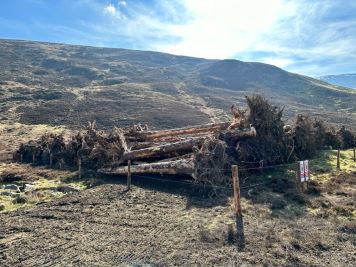Major Conservation Grant Awarded for River Clunie Works
Angus MacNicol for Invercauld Estate
It may not have looked like it for much of last summer, but a lot of water flows through the catchment of the River Clunie south of Braemar. Covering over 40 square miles of Invercauld Estate up to Glenshee Ski Centre, the catchment includes the Callater and Baddoch glens as well as the main stem of the Clunie itself. Loch Callater, which is around 8 kilometers south-east of Braemar, collects around 20% of the water that ultimately flows through the River Clunie by the time it reaches the village.
Work of Gamekeepers
This catchment is a hive of activity, focussed on conservation of the environment for nature (including mankind). In the hill our gamekeepers burn heather to encourage it to naturally regenerate and manage foxes and weasels which eat the eggs of grouse and other ground nesting birds. They also control the number of wild red deer to maintain these at sustainable level, providing sport and food into the bargain.
Some of the conservation undertaken in the catchment however is perhaps more apparent to the casual observer and this is so particularly in and adjacent to the water. Over the past ten years or so, the Dee District Salmon Fishery Board and River Dee Trust have been working with Invercauld to install thousands of trees on the banks of the Clunie, Callater and Baddoch. Some of these can be seen when driving along the A93. The intention is that once they are grown, the shade from these trees will provide a cooling effect in the water for salmon and pearl mussels and also a source of insects for young fish.

 400 x 267.jpg)
Awarded Nature Restoration Grant
Recently, we were delighted that NatureScot awarded a major grant of £209,000 from its Nature Restoration Fund to undertake more work in this riparian environment. This will include the installation of 'woody debris' in some sections of the River Clunie with a low gradient. This involves long tree trunks with their roots still attached being driven deep into the bed of the river, mimicking a process that happens naturally. Over time eddying caused by the tree roots creates pools of deeper water for fish and other wildlife. A significant number of these woody debris structures have already been installed in the River Gairn in the northern part of the estate. It is hoped the woody debris will also slow the River Clunie to a degree, although unfortunately we would not expect this to be significant enough to help when we face extreme flood events like Storm Frank.


Additional Restorative Works
Other work under the project will include digging wader scrapes. A number of these have also been created at Invercauld over recent years where a digger makes a shallow bowl in the ground with gently sloping sides - these then fill with water and the chicks of wader species such as curlew and lapwing are able to make a short walk to partake of some light refreshment. Additional tree planting along the edge of the river will also be carried out as the project progresses, along to those already planted.
You may see some of this work underway over the next few months if you are driving south on the road or out enjoying a walk on some of the hill tracks south of Braemar. Hopefully over time it will help in the management of this precious environment and the huge volume of water that runs through it.
